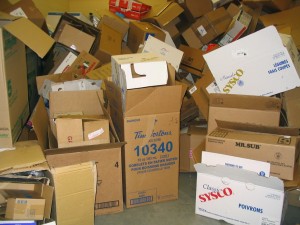by Brenna Timm
Taken for Granted
Cardboard is something that we all use on a regular basis, whether we are shipping or receiving orders, or creating a school project. Considering how much we use the material in our daily lives, we know surprisingly little about the material. Let’s investigate some of the ins and outs of the overlooked world of cardboard.

Different Types
It may come as a surprise, but cardboard is a very broad term. What we call cardboard includes anything from cereal boxes and card stock to paperboard and the fancy corrugated cardboard. It is the corrugated cardboard that most people imagine when we think of our Amazon orders and moving boxes. This would be the type with the wavy sheet (this is the corrugated part) sandwiched between flat sheets. As long as you are part of the general public and not in the shipping or packaging industry, this is all you need to really know. But there are multiple different styles and types of corrugated cardboard, all with different names, strengths, and purposes.
Truth of Cardboard
Contrary to some views of sustainability and recycling, cardboard is a sustainable packaging material. The material as a packaging product really does make our lives easier, and it doesn’t have nearly as much harm on the environment as some options. It is much easier to produce into different sized boxes to accommodate all of your shipping and purchasing needs. Consider how in years past, our options for transporting products were generally limited mostly to crates. In our society, this doesn’t make sense.
On the other side of the matter is recycling. Cardboard breaks down very easily when compared to plastic and glass products. It goes through a natural decomposition, unlike its rivals. This gives the product a big advantage when we consider our consciousness of reusing and recycling.
Recycle Your Boxes
It is easiest to just through your box into the recycling bin and let the professionals take care of it. However, this isn’t the most helpful. Taking just five more minutes, you can make everyone’s job better. Start by removing any material, debris, or plastic lining from the cardboard, since this doesn’t recycle the same. Next, break down the box so that it becomes flat. Use scissors or a utility knife to cut through any tape keeping the sides together. Some boxes can be done at this point, if they are smaller than 2 ft by 2 ft when broken down, or they fit comfortably in your bin. Otherwise, take your utility knife to cut the flattened box into more manageable pieces that fit your recycling bin. This will make your recycling company’s job more efficient.




